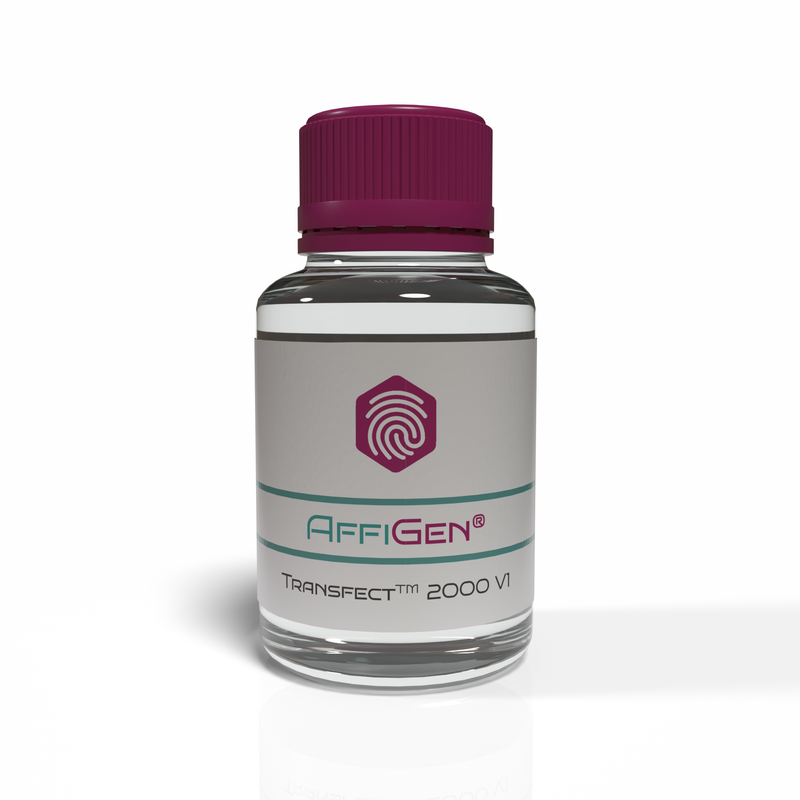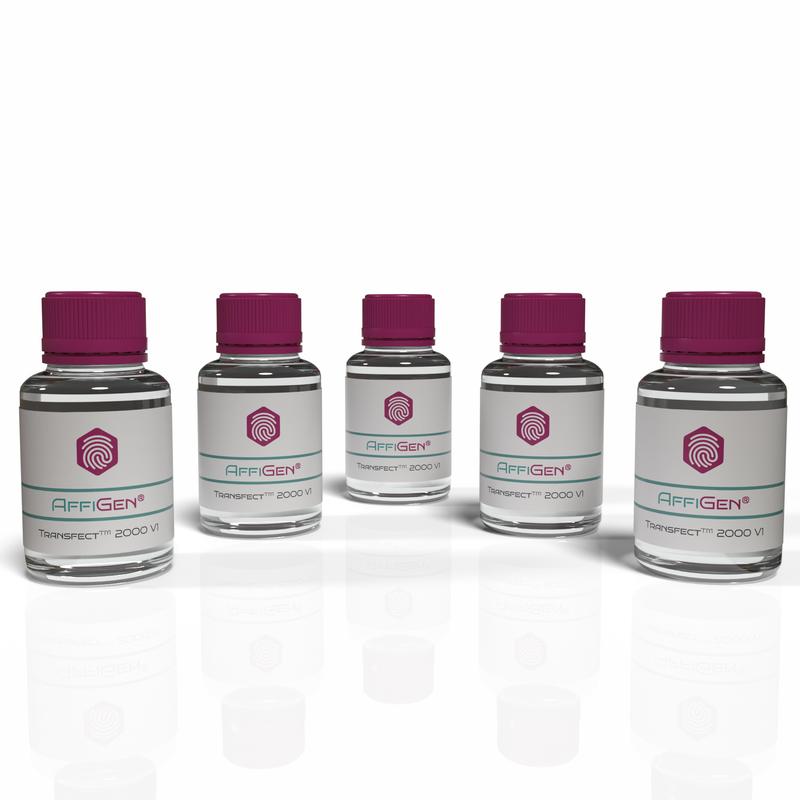


AffiGEN® TransfectTM siRNA In Vitro 2000
Introducing AffiGEN® TransfectTM siRNA In Vitro 2000, a groundbreaking biodegradable non-liposomal solution designed for efficient siRNA/miRNA and DNA delivery. Powered by our proprietary pH Dependent Conformational Change (PDCC) technology, this innovative transfection reagent sets new standards by incorporating pre-screened hydrophobic groups into its side chain. The result is a versatile and potent gene delivery tool that stands at the forefront of the market.
Key Features:
- Unmatched efficiency in delivering single siRNA/miRNA or co-transfecting DNA/siRNA or DNA/miRNA into a wide range of mammalian cells.
- Exceptional gene silencing efficacy even at low concentrations, with as little as 1.0 nM siRNA/miRNA mimics.
- Mitigates non-specific and off-target effects within the cellular environment.
- Simplified one-tube reaction process for ease of use.
- Ideal for use across diverse mammalian cell types.
- Remarkably low cytotoxicity ensures cell viability.
- Cost-effective without compromising quality.
Package:
AffiGEN® TransfectTM siRNA In Vitro 2000 (1.0 mL): Ample supply for approximately 2,000 reactions, allowing transfection of 5.0 pmol siRNA or miRNA mimics in a 24-well plate.
AffiGEN® TransfectTM siRNA In Vitro 2000 Buffer (5X): A carefully formulated solution (8.0 mL) that, when mixed, yields 40 mL of a working solution optimized for maximal transfection efficiency.
Applications:
- Perfect for single siRNA transfection or co-transfection of DNA/siRNA into various mammalian cells.
- Tailored for single miRNA, miRNA mimics, or inhibitors transfection, as well as co-transfection of DNA/miRNA or DNA/miRNA mimics into a diverse array of mammalian cells.
Storage:
AffiGEN® TransfectTM siRNA In Vitro 2000: Store at 4°C.
AffiGEN® TransfectTM siRNA In Vitro 2000 Buffer (5X): Store at room temperature (RT).
With proper storage, the product maintains stability for at least 12 months or longer, ensuring reliability and longevity. AffiGEN® TransfectTM siRNA In Vitro 2000 is your go-to solution for precise and efficient gene delivery in your research.
siRNA In Vitro Transfection Reagents Specifications and Guide Application
| Product | AffiGEN® TransfectTM siRNA In Vitro 1000 | AffiGEN® TransfectTM siRNA In Vitro 2000 | AffiGEN® TransfectTM siRNA In Vitro 3000 | AffiGEN® TransfectTM siRNA In Vitro 4000 | AffiGEN® TransfectTM siRNA In Vitro 1000 Plus |
| Nucleic Acid | siRNA | siRNA, miRNA, DNA | siRNA | siRNA | siRNA |
| Technology | Peptide-based | Non-liposomal | Liposome formulation | Polymer-based | Peptide-based |
| Efficiency | High | High | High | High | High |
| Cell compatibility | Wide | Wide | Wide | Wide | Wide |
| Off-target effects | Low | Low | Low | Low | Low |
| Cytotoxicity | Moderate | Moderate | Low | Very Low | Moderate |
| Package sizes | 1 mL, 5X 1 mL | 1 mL, 5X 1 mL | 1 mL, 5X 1 mL | 1 mL, 5X 1 mL | 1 mL, 5X 1 mL |
| Storage | 4°C, Buffer at RT | 4°C, Buffer at RT | 4°C, Buffer at RT | 4°C, Buffer at RT | 4°C, Buffer at RT |
| Applications | Gene silencing, RNAi | Gene silencing, miRNA delivery, DNA delivery | Gene silencing | Gene silencing | Gene silencing |
| Target Organisms | Mammalian cells | Mammalian cells | Mammalian cells | Mammalian cells | Mammalian cells |
| Cell Types Suitable For | Wide range of cell types | Wide range of cell types, including primary cells, stem cells, and difficult-to-transfect cells | Wide range of cell types | Wide range of cell types, including suspension cells and difficult-to-transfect cells | Wide range of cell types, including hard-to-transfect cells |
| Additional Notes | N/A | Can be used for in vivo applications | N/A | Optimized for siRNA delivery, but can also be used for DNA transfection | Effective at low concentrations |
Standard Protocols:
Protocol I: siRNA Transfection per Cell Culture Vessel
1. Preparation of Working Solution (1X):
- Dilute the Transfection Buffer (5X) with ddH2O at a 1:4 ratio to obtain a Working Solution (1X). Store at room temperature for up to 24 months.
2. Cell Seeding:
- Plate cells 18 to 24 hours prior to transfection to achieve approximately 50% confluency at the time of transfection.
- Add complete medium containing serum and antibiotics to each vessel 30-60 minutes before transfection.
3. siRNA Transfection:
- Recommended siRNA concentrations range from 1 to 100 nM. Start with 5.0 nM siRNA for most adherent cell lines, adjusting to 50 nM for challenging cell types.
- Follow these steps per vessel:
4. Assessment:
- Evaluate gene silencing 24-72 hours after transfection using appropriate assays. Adjust conditions based on cell type and experimental requirements.
Protocol II: DNA/siRNA Co-transfection:
1. Preparation of Working Solution (1X):
- Dilute the Transfection Buffer (5X) with ddH2O at a ratio of 1:4 to create a stable Working Solution (1X). Store at room temperature for up to 24 months.
- Note: Maintain the Transfection Buffer (5X) at room temperature to prevent precipitation. Refrigeration may induce white precipitates, which do not compromise transfection efficiency. Upon dilution to Working Solution (1X), any precipitates will dissolve.
2. Cell Seeding:
- Plate cells 18 to 24 hours before transfection to achieve approximately 70% confluency at the time of transfection.
- Add complete medium containing serum and antibiotics to each vessel 30-60 minutes before transfection.
- Note: The Transfection Reagent is compatible with serum and antibiotics throughout the experiment.
3. DNA & siRNA Co-transfection Protocol:
- Recommended for each vessel: Use 0.3-0.5 µg DNA and 1-20 nM siRNA, starting with 0.5 µg DNA and 10 pmoles siRNA (final concentration 10 nM) per vessel.
- Follow these steps per vessel:
4. Assessment:
- Assess gene silencing 24-72 hours post-transfection. Adjust parameters based on cell type and experimental requirements.
Protocol III: DNA transfection to Mammalian Cells
1. Preparation of Working Solution (1X):
- Dilute the Transfection Buffer (5X) with ddH2O at a ratio of 1:4 to create a stable Working Solution (1X). Store at room temperature for up to 24 months.
- Note: Maintain the Transfection Buffer (5X) at room temperature to prevent precipitation. Refrigeration may induce white precipitates, which do not compromise transfection efficiency. Upon dilution to Working Solution (1X), any precipitates will dissolve.
2. Cell Seeding:
- Plate cells 18 to 24 hours before transfection to achieve approximately 80% confluency at the time of transfection. Add complete medium containing serum and antibiotics to each vessel 30-60 minutes before transfection.
- Note: the Transfection Rreagent is compatible with serum and antibiotics throughout the experiment.
3. DNA Transfection Protocol:
- Recommended for each vessel: Use 0.5 to 1.0 µg DNA per well in a 6-well plate. Starting with 1.0 µg DNA and 3.0 µL of the Transfection Reagent per well typically yields satisfactory efficiency without visible toxicity.
- Follow these steps per vessel:



